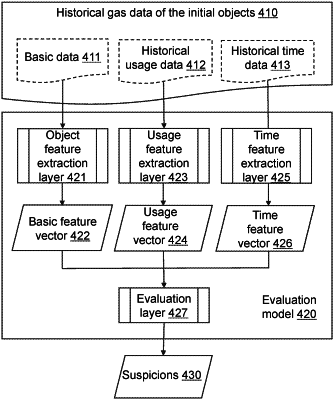| CPC H04Q 9/02 (2013.01) [H04L 67/12 (2013.01); H04Q 2209/60 (2013.01)] | 7 Claims |

|
6. An Internet of Things system for gas usage safety warning based on a smart gas, wherein the Internet of Things system comprises a smart gas user platform, a smart gas service platform, a smart gas safety management platform, a smart gas household device sensing network platform and a smart gas household device object platform interacted in sequence, wherein the smart gas safety management platform includes a smart gas household safety management sub-platform and a smart gas data center, the smart gas data center is configured to:
obtain gas usage data from at least one gas device through the smart gas household device sensing network platform and send the gas usage data to the smart gas household safety management sub-platform, wherein the at least one gas device is configured in the smart gas household device object platform; and
the smart gas household safety management sub-platform is configured to:
based on the gas usage data, determine a gas monitoring object from the at least one gas device;
determine initial objects based on the gas monitoring object and a gas usage threshold;
process historical gas data of the initial objects by using an evaluation model to determine suspicions of the initial objects, wherein the evaluation model is a machine learning model, the evaluation model is obtained by a joint training, the evaluation model includes an object feature extraction layer, a usage feature extraction layer, a time feature extraction layer and an evaluation layer, wherein
the object feature extraction layer is used to process basic data of the initial objects to determine a basic feature vector, the basic data includes data related to a device state of the initial object;
the usage feature extraction layer is used to process the historical usage data of the initial objects to determine a usage feature vector, the historical usage data includes a usage length, a usage amount per unit time of a gas device;
the time feature extraction layer is used to process historical time data of the initial objects using gas to determine a time feature vector, the historical time data includes a start usage time point, an end usage time point, a usage count per day, and a usage count per week of the gas device;
the evaluation layer is used to process the basic feature vector, the usage feature vector and the time feature vector to determine the suspicions of the initial objects;
determine, based on the suspicions and a suspicion threshold, a target object, the suspicion threshold being determined based on feedback information of a gas user; and
send gas safety warning information to the smart gas data center and to the smart gas user platform of the gas user corresponding to the target object via the smart gas service platform.
|